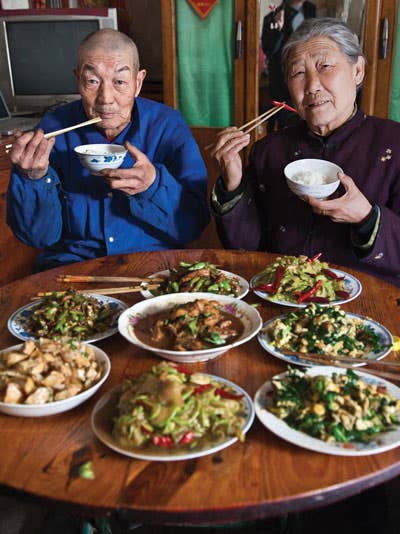
The stir-fry is the scent and sound of my childhood. Every night, my mother, a native of Zhongshan, in southern China, made dinner using her trusty two-handled wok. My sisters and I loved to watch as her worn cleaver produced heaps of perfect meat and vegetable slices. She seemed to move to a music we couldn't hear, adding things to the wok, taking them away, scooping and tossing with her metal spatula, as the various ingredients coalesced into a dish we loved. We lived in New Jersey, shopped for groceries in New York's Chinatown, ate Chinese food daily, and spoke a blend of Mandarin and English. Then, when I was ten years old, my mother succumbed to stomach cancer. My sisters and I never spoke Mandarin again; our father, though himself an immigrant from Shanghai, had his hands full with four daughters and didn't insist upon our using the language the way our mother had. With her gone, we lost our connection to a larger Chinese community. In place of the nightly ritual of marinating and chopping, the clang and scrape of spatula against wok, the aroma of garlic and ginger that had filled the kitchen, our father could offer only Chinese takeout.
I did learn to cook, but not until after I'd left home. I ended up going to culinary school and working as a pastry chef in restaurants in New York, Korea, Japan, and Singapore. But in all my travels, I never made it to China. Back in New York, as an editor at Gourmet magazine, I was called upon to develop recipes from Shanxi, Xinjiang, and Shangrila, and I was astounded all over again by the range of dishes a wok could produce. Little by little, China was catching up with me; finally, I decided to let it.
I arrived in Beijing on a cold winter evening last year, determined to stay as long as it would take to master Mandarin and to understand, through cooking and eating, what it means to be Chinese. At first I was disappointed with what I ate in the city; the food was so different from my mother's fresh-tasting, delicately seasoned Cantonese cooking. But I've since come to appreciate the hearty dishes and the liberal use of vinegar, salt, and oil that characterize northern Chinese cooking. Besides, Beijing is a cosmopolitan city; I've met cooks from all over China, and they've happily instructed me in the ways of their respective regional cuisines. Stir-frying is the common denominator they all share—not a single technique, but a whole approach to cooking that encompasses many different methods for preparing dishes in a wok. At its most basic, it is the act of cooking quickly over high heat, with ingredients added to the wok in a measured progression so that each one cooks to the point of optimal flavor and texture; constant stirring and flipping ensures that every morsel gets equal exposure to the center of the wok, where the heat is the most intense. But as I go from kitchen to kitchen, I'm learning that stir-frying is a more sophisticated art than I'd ever imagined.
Wang Mingjun—slim, bespectacled, with a frenetic energy that makes her seem younger than her 49 years—has become my adopted laoyi, or aunt, and that's what I call her. I frequently visit her in her government-subsidized apartment complex in western Beijing. I met her through her niece, Annie, a fellow ABC (American-born Chinese) living in Beijing. When I complimented Laoyi on her wok, she hustled me right over to her neighborhood market to buy one just like it: cast-iron, curved like a bell, with three stubby feet. "You must have a proper wok!" she proclaimed in her guttural Beijing accent. This is a refrain I've heard from many cooks here. A good wok is the foundation of good cooking; stir-frying is said to activate food with the wok's energy. It will be years, though, before my wok acquires the well-seasoned patina that Laoyi's has. That seasoning, accumulated over thousands of stir-fries, not only imparts flavor but also acts as a natural nonstick surface.
Laoyi's small kitchen is fairly typical: a gas stove with two powerful burners, no oven, a crock pot always on the boil. Before I'm even through the door, she's pushing snacks on me: "Have a chicken leg. You should eat something before we start to cook." Laoyi is adamant about how things are made, even if the dish is something so seemingly simple as a stir-fry of tomatoes and eggs. Her tomato wedges, absolutely uniform in size to ensure even cooking, are piled on a cutting board along with tidy piles of sliced garlic and chives. Because precise timing is crucial in stir-frying, everything must be within easy reach of the wok, which Laoyi allows to get very hot before she begins swirling peanut oil around inside it.
Laoyi's stove is enclosed on three sides by a plastic spatter guard; it's as if she's cooking inside a movie theater popcorn machine. She seasons with an expert hand, bringing mediocre winter tomatoes to life with a little salt and sugar. She sets down plates of food along with small bowls of rice on a card table in her living room, which also serves as her bedroom. I sit on the bed; she sits on the adjoining sofa. "The balance of flavors is everything," she says, and as I tuck into the fluffy eggs and salty-sweet tomatoes, I have to agree.
If you're using high-quality ingredients, there's all the more reason to opt for a straightforward stir-frying technique that will allow the food's true character to shine through. No one has made this clearer to me than Pan Suefen. A 50-something native of Taiwan, she is as gentle and serene as Laoyi is brash and intense. Her lilting southern accent is closer to what I grew up hearing; her light touch in the kitchen is familiar, too. Early on, we commiserated over Beijing's gut-busting local cuisine, and I soon learned that beneath Suefen's gentle demeanor lies a steely will: until recently, she owned a Taiwanese restaurant here, but when she started feeling pressure to adjust her dishes for local tastes, she abruptly closed it.
At home, she remains fanatical about sourcing her ingredients. For instance, to make sure she gets the intensity of flavor she requires, she dries fresh shiitake mushrooms herself in her living room, spreading them out on newspapers that cover every available surface. Their earthy taste and fragrance seem to magnify many times over in the process.
For such a fussed-over ingredient, Suefen insists, no sauce, no aromatics are called for; just heat, oil, salt, and sugar, applied with care. The mushrooms are cooked with bok choy, and what might be a rather austere dish in lesser hands bursts with flavor when it emerges from Suefen's wok. As she slices leeks to stir-fry with strips of pork for another dish, she is absolutely precise—everyone I know here has incredible knife skills. While the leeks cook, the pork marinates. The entire, deliberate progression is utterly economical. Not a moment or a speck of food is wasted.
Another of my teachers is Deng Haiyan, a 35-year-old native of Shandong province, on China's northeastern coast. She works as a nanny and cook for a British family I know in Beijing's upscale Chaoyang neighborhood; everyone calls her Maggie. Most of the time she speaks softly with her head bowed, but when she's in the kitchen, she's proud, almost bossy, particularly when stir-frying her specialty: hong shao rou, or red-cooked pork belly. In red cooking, meat is simmered in a rich soy sauce reduction. Maggie stir-fries the pork, simmers it until it's very tender, and then stir-fries it again to create a concentrated, intensely savory flavor.
What strikes me above all as I observe all of these women at the stove is the way that just a few elements—wok, oil, a handful of ingredients—can produce endlessly varied results depending on how a cook chooses to use them. When I ask Maggie if she can demonstrate the famed southern Chinese velveting technique, in which meat is marinated in a blend of egg white and cornstarch and then blanched in oil to seal in its juices, she nods smartly, picks up the chicken and celery she happens to have at hand, and gets to work. In minutes, she produces the tenderest chicken I've ever eaten—silky without being greasy, light and luscious at the same time.
If Mingjun is my laoyi, then Sun Guoying is my popo (grandmother). She is 75 years old and lives at the base of the Great Wall, in the village of Mutianyu, on the outskirts of greater Beijing. When my friend William, who grew up across the road from Guoying's low-slung stone farmhouse, first took me to meet her, I instinctively gave her a very un-Chinese hug, which made her laugh. I guess it was her easygoing cheerfulness that put me at ease, too.
After a lifetime of farming, Guoying is indefatigable. When I try to help with prepping ingredients, she snatches the cleaver from me, her eyes smiling. Her husband, Li Zhongzhou, lights a wood fire under the chuantong guo, a traditional built-in wok. The fire's smoke subtly infuses everything that passes through the chuantong guo, and its powerful heat puts a sear on food in a matter of seconds.
Guoying makes the best noodle stir-fry I've tasted, though she finds it hilarious when I wax on about it. She calls it tian tian chao mian—everyday fried noodles. Just as Suefen did with her pork-and-leek stir-fry, Guoying cooks the vegetables before the meat, adding carrots and onions to the wok first and stirring them until they begin to soften. When it's time, she adds a fistful of ground pork; meat is a luxury, something she typically uses more as a condiment than as the centerpiece of a dish. Finally, wheat noodles are stirred in to bring all the elements together.
I notice that Guoying has another wok in addition to her wood-fired one; it's bell-shaped with three feet, like mine. I tell her that I envy its wood handle, split and mended with wire though it is; it's so much more practical than the metal handle on my newer model. Her wok's well seasoned interior is rippled with tiny fissures, like the face of someone very old. It's beautiful. To my great surprise, she insists that I take it with me when I go. And then I understand. "You'll come back and see me," she says, fixing me with her smiling eyes. The wok is our bond.
Keep Reading
Continue to Next Story










